Though I posted last week at some length about my favorite greens, I was in fact telling a tale. If I had to choose between lima beans and farfugium, I would gladly do without the lima beans. The vast majority of a garden is green-this makes picking favorites difficult. But farfugium crispata has an especially gorgeous green leaf; large, undulating, and in this case, heavily ruffled. 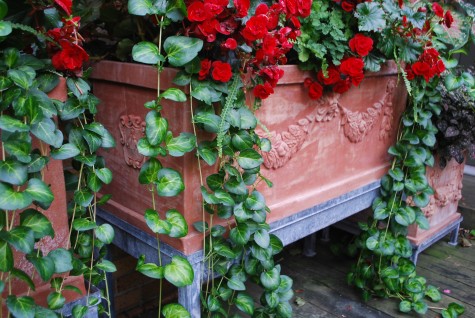 The trailing vinca maculatum has a thick glossy leaf, with both forest green and lime markings-but it is the habit of the plant that gets my attention. This plant will send out runners all season long, and trail two stories, given the chance. During the fall cleanups, I potted up every plant I had planted in containers in May. They were still growing vigorously, the beginning of November. I am interested to see what they might go on to become next season. This green plant has it all over the traditional vinca vine one sees in container plantings. They would make a swell start for a hanging garden.
The trailing vinca maculatum has a thick glossy leaf, with both forest green and lime markings-but it is the habit of the plant that gets my attention. This plant will send out runners all season long, and trail two stories, given the chance. During the fall cleanups, I potted up every plant I had planted in containers in May. They were still growing vigorously, the beginning of November. I am interested to see what they might go on to become next season. This green plant has it all over the traditional vinca vine one sees in container plantings. They would make a swell start for a hanging garden.
 Selaginella, or club moss, is a spreading green plant with tiny scale-like leaves. They like moist shade, and will spread indefinitely if they are happy. They make great container plants, in combination with upright growing plants that will not shade them out completely. They are great in combination with begonias and tropical ferns. This lime green version is especially handsome with a big leaved pepperomia. The pepperomias-I cannot believe I left them off this list. I like them all; the more the better.
Selaginella, or club moss, is a spreading green plant with tiny scale-like leaves. They like moist shade, and will spread indefinitely if they are happy. They make great container plants, in combination with upright growing plants that will not shade them out completely. They are great in combination with begonias and tropical ferns. This lime green version is especially handsome with a big leaved pepperomia. The pepperomias-I cannot believe I left them off this list. I like them all; the more the better.
 Green and gold plectranthus is a vigorous and lax growing green planted, sporting large felted leaves. They are related to coleus. The plant can be pruned into shapes if pinched regularly-just like a coleus. They grow large, so they need big company. This zebra grass rises above the fray, as my friend Denise would say.
Green and gold plectranthus is a vigorous and lax growing green planted, sporting large felted leaves. They are related to coleus. The plant can be pruned into shapes if pinched regularly-just like a coleus. They grow large, so they need big company. This zebra grass rises above the fray, as my friend Denise would say.
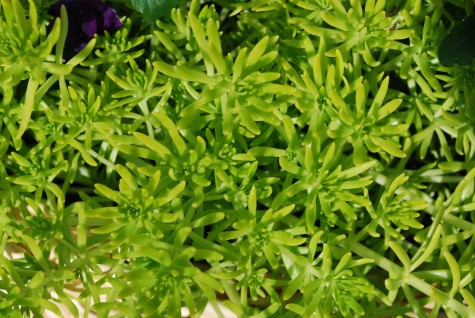 Angelina is a succulent which is hardy for me. I have had it winter over in pots; I have had it stay green, wintering over in pots. It trails just enough to make it good in any size pot. Any scrap of a piece that falls on the ground roots. Willing, this plant.
Angelina is a succulent which is hardy for me. I have had it winter over in pots; I have had it stay green, wintering over in pots. It trails just enough to make it good in any size pot. Any scrap of a piece that falls on the ground roots. Willing, this plant.
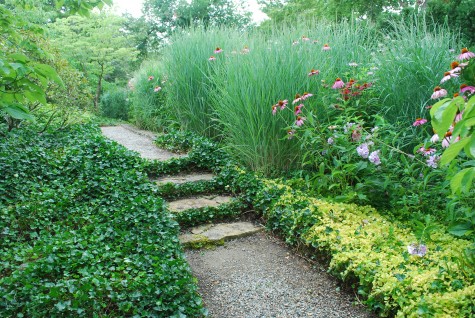 There are plenty of greens represented here-the panic grass is my urban version of a meadow. The baltic ivy was here when I moved here, and it still going strong 15 years later. I planted a few planted of lysimachia nummularia aurea-the lime version of creeping jenny, on the edge of this path. 2 years later it is holding its own with the ivy. The combination of the two groundcovers is interesting. Creeping jenny trails long in pots and window boxes. It is equally at home in boggy locations, or at the water’s edge. It will burn in full sun unless it has constant moisture. The best lime color requires a part sun-part shade location.
There are plenty of greens represented here-the panic grass is my urban version of a meadow. The baltic ivy was here when I moved here, and it still going strong 15 years later. I planted a few planted of lysimachia nummularia aurea-the lime version of creeping jenny, on the edge of this path. 2 years later it is holding its own with the ivy. The combination of the two groundcovers is interesting. Creeping jenny trails long in pots and window boxes. It is equally at home in boggy locations, or at the water’s edge. It will burn in full sun unless it has constant moisture. The best lime color requires a part sun-part shade location.
 Polka dot plant, or hypoestes, has similar requirements. Popular as house plants, new cultivars such as pink splash, do well in containers in partially shaded locations. They can be made to grow in full sun locations, but you need be very mindful of the water. They make a great supporting cast plant for shade loving tropicals or caladiums. As you can see, they mix well with lime licorice too. The white spots help lighten up a really shady location.
Polka dot plant, or hypoestes, has similar requirements. Popular as house plants, new cultivars such as pink splash, do well in containers in partially shaded locations. They can be made to grow in full sun locations, but you need be very mindful of the water. They make a great supporting cast plant for shade loving tropicals or caladiums. As you can see, they mix well with lime licorice too. The white spots help lighten up a really shady location.
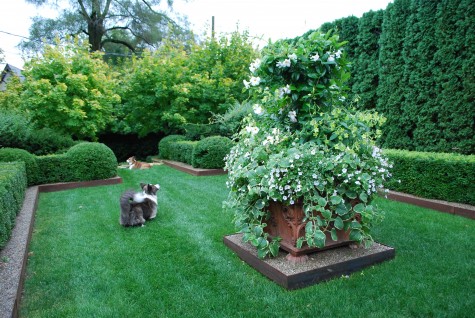 Most places in my yard are green. This large pot has a little white from a mandevillea and some petunias, but the lime nicotiana alata and gren and white plectranthus keeps the green dominant. In a mostly green garden, the visual focus shifts to texture, shape, surface, volume and mass-all things that interest me.
Most places in my yard are green. This large pot has a little white from a mandevillea and some petunias, but the lime nicotiana alata and gren and white plectranthus keeps the green dominant. In a mostly green garden, the visual focus shifts to texture, shape, surface, volume and mass-all things that interest me.

I do not miss seeing the concrete block wall that is completely obscured by this boston ivy. 600 square feet of concrete in the vertical plane-not so pretty. This green plant securely attached itself to it, and grew without any attention from me. When it sheds its leaves, I can see that 15 years of attachment to this wall has not damaged it in the least bit. I am sure I could write about good greens every week for years, and not get to the end of them. This green part of gardening is great fun.
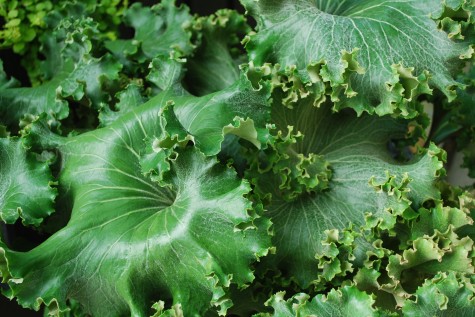
Leave a Comment